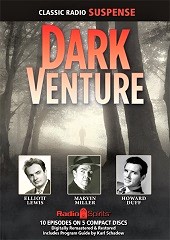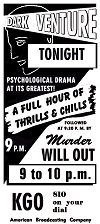Darkness is the absence of Light . . .
So in the sudden shadows which fog the minds of men and women
. . . into the unknown.”
Dark Venture (1945-47) aired “The Miser” on December 9, 1946. This is only the fifth episode we have run of Dark Venture, whose series focus is best expressed as the “psychological thriller,” the first being in 2018 and the last being in September of of 2021. Aside from the fact that there were 130 or so episodes of which a mere dozen survive, there is so much mis-information, innacurate information, and conflicting information among many online old time radio websites (some reportedly reputable and authoritative), that I turned to long-time friend of this show and Golden Age of Radio historian Karl Schadow for help. Karl wrote the liner notes for the Radio Spirits CD collection of Dark Venture (pictured above left), and with his kind permission–-and my thanks–-I will excerpt from his far more in-depth introduction, wherein he details the history of this under-appreciated radio show.
“Dark Venture premiered on June 5, 1945, enjoying a continuous run through December of 1947. During this thirty-one month period, all of the episodes were produced and broadcast from various facilities of station KECA, ABC’s Hollywood affiliate. The cast was an interesting mix of performers. Not only were elite actresses Jeanne Bates, Betty Moran and Lurene Tuttle featured in the series, but opportunities were also bestowed upon radio newcomers Daphne Drake and Martha Shaw. The men’s roles were often given to stalwarts Charles Lung, Earl Ross and Bill Johnstone. Stage and screen stars occasionally appeared on the program as well, resulting in impressive individual performances by William Tracy and Carl Harbord.
“For the first ten months, Dark Venture was a regional feature, limited to broadcast on ABC’s Pacific Coast network, which consisted of fifteen stations in five states. After commencing on Wednesday’s at 9 pm, the program moved to Tuesdays in July of 1946. It is currently unknown why ABC did not initially route the program to the entire nation. However, on February 19, 1946, it did achieve full network coverage. Two months into this series, the New York Times (April 7,1946) published Larry Marcus’ compliment to the wisdom of his audience, who demanded scripts that would have to involve “believable characters and natural situations out of which will spring movement and suspense…to tell an honest story of emotional upheaval.”
…
“On April 16th, 1946, Dark Venture entered the commercial ranks. The Wildroot Company, through its long-time advertising agency Batten, Barton, Durstine & Osborn, signed on as sponsor to promote its Cream-Oil Hair Tonic through April 8, 1947.”
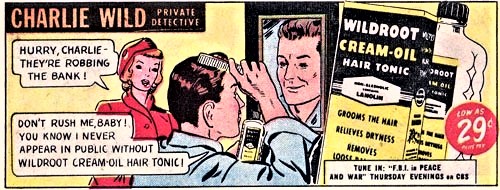
…
“Past aired episodes of Dark Venture (from 1946) were adapted for use by the Armed Forces Radio Service (AFRS) and broadcast without Wildroot’s promotional copy. The program was one of many to be featured on the AFRS Mystery Playhouse. Hunter Galloway was this series’ narrator.”
“The Miser” tells the story of a man who is decent at heart but who makes a wrong choice in a moment of weakness. This ill-advised decision quickly reveals itself when the man becomes squeezed in the ever tightening coils of his own deception, eventually painting himself in a corner from which he finds there is no escape. It is easy to do the right or moral thing when everyone is watching, but who among us is strong enough to do the right thing when no one is near, when only our conscience is witness to our inner strength (or weakness)? The poor, misguided soul in “The Miser” learns the hard way that Murphy is an ever-present force that given half a chance will claim a victim every time.
(The linked CD at top includes this episode and 9 others, all digitally remastered,)
Play Time: 29:21
{“The Miser” aired on a Monday evening a couple of weeks before Christmas in 1946. The neighborhood gang knew that a holiday vacation would soon be at hand but that it couldn’t come quickly enough for them, so made haste for the nearby newsstand the next day after school. They would need some of their favorite reading to pass the time more quickly, until the Christmas morning they were dreaming of would become a reality. Detective Tales (1935-53) was an extremely popular detective pulp, running as a monthly for almost the entirety of its 18-year existence, reducing to a bi-monthly schedule only for its last 2 1/2 years. It was a monthly in 1946. Dime Detective (1931-53) enjoyed an even longer and more prosperous run than did Detective Tales, with its 274 issues to Detective Tales’ 202. Like DT, Dime Detective saw most of its run as a monthly (with a stint from 1933-35 as a twice monthly), and finished its run as a bi-monthly its last 3 years. It too was a monthly in 1946. Thrilling Detective (1931-53), also began in 1931, as did Dime Detective, and like it and Detective Tales ran as a successful monthly for the greater proportion of its long and successful life, making the 200+ issue mark as did its fellow detective pulps. In common with the other pulps showcased here it too became a bi-monthly for its final few years, in this case from 1946 until its demise in 1953, marking 1953 as the final curtain for all three magazines.}
[Left: Detective Tales, 12/46 – Center: Dime Detective, 12/46 – Right: Thrilling Detective, 12/46]
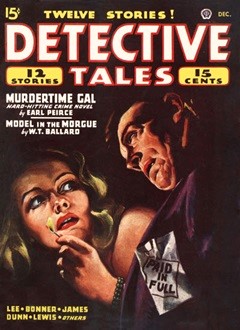
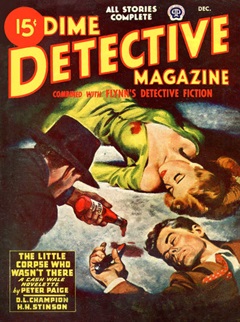
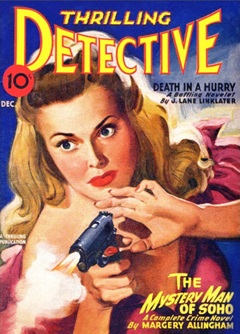
To view the entire list of weekly Old Time Radio episodes at Tangent Online, click here.
